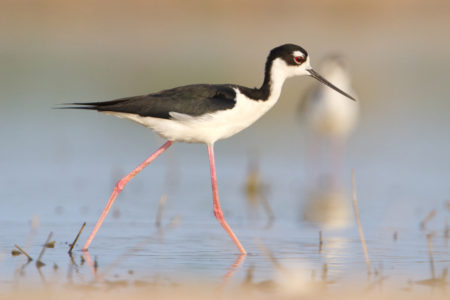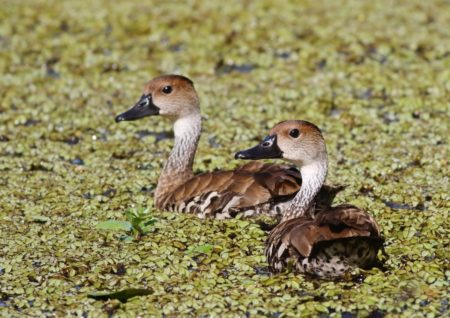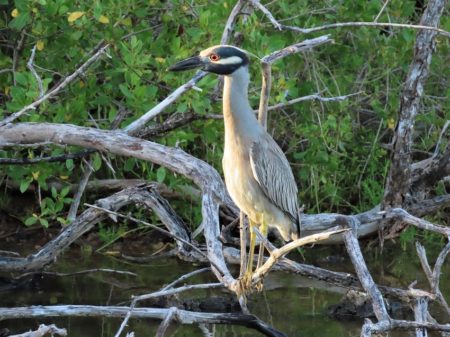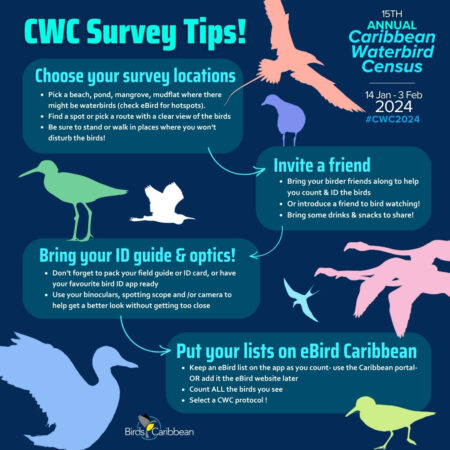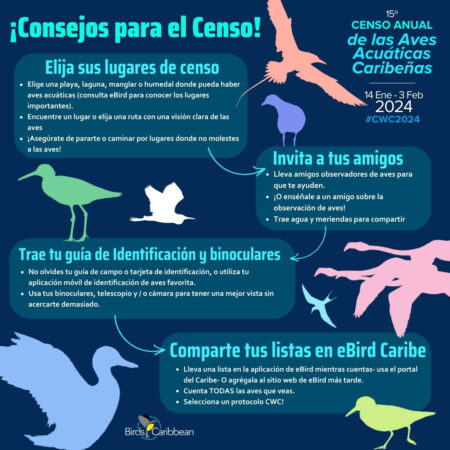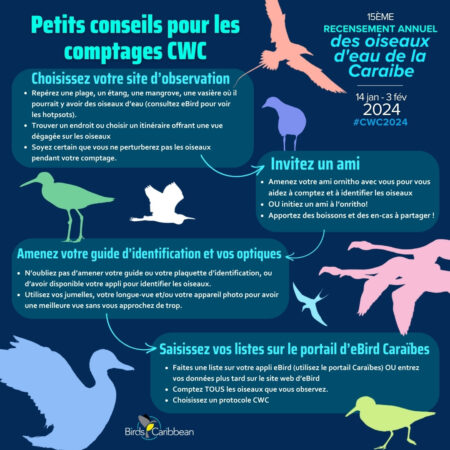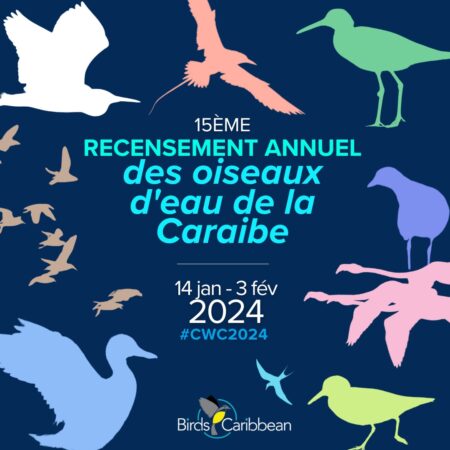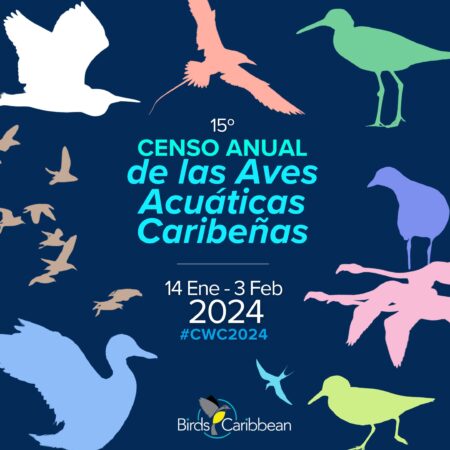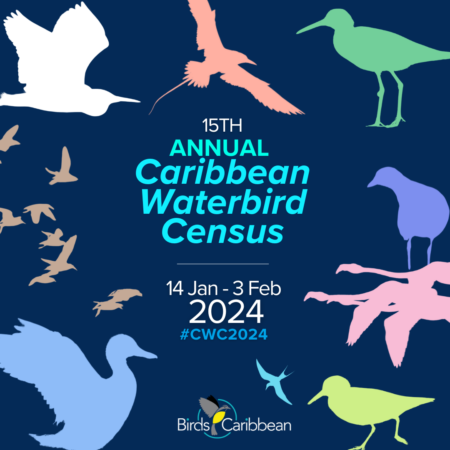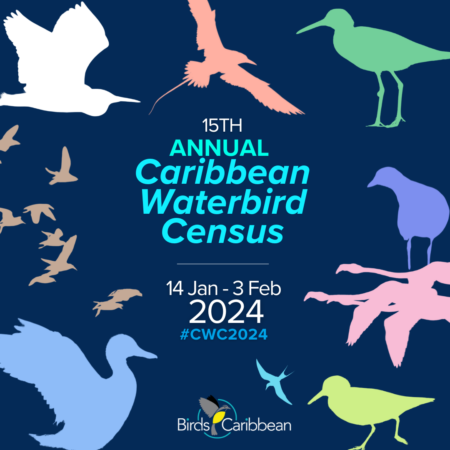 Get ready for the 15th annual Caribbean Waterbird Census (CWC) Region-Wide count! From January 14th to February 3rd 2024, you can directly contribute to Caribbean Waterbird conservation—keep reading to find out everything you need to know about our CWC 2024 count.
Get ready for the 15th annual Caribbean Waterbird Census (CWC) Region-Wide count! From January 14th to February 3rd 2024, you can directly contribute to Caribbean Waterbird conservation—keep reading to find out everything you need to know about our CWC 2024 count.
We are now a fantastic 15 years into the CWC Annual Regional Count. This year, you can help us add to this important long-term dataset! The 2024 count begins on Sunday January 14 and runs until Wednesday, February 3.
The Caribbean is home to over 185 species of waterbirds, including a number of endemic and globally threatened species and many migrants. The data you help us collect in this ongoing, standardized survey is essential for helping us understand how to best conserve this exceptional group of birds and manage their habitats. Over the 15 years of the CWC regional count the data collected has helped us in so many ways! For example, the Cargill Salt Ponds in Bonaire were designated a Western Hemisphere Shorebird Reserve Network (WHSRN) site of Regional Importance as a direct result of survey efforts. In addition, surveys in Turks and Caicos have revealed important sites for many shorebird species, including birds of conservation concern such as the Piping Plover and rufa Red Knot! CWC surveys are also critical in keeping up to date with any changes and threats to waterbirds and their wetland homes.
Anyone can participate in the CWC—just head out to your nearest wetland or beach, and record the birds you see. You can find detailed information about how to conduct surveys here. Why not wade into the wonderful world of waterbirds?
What makes a wetland?
During the CWC count you’ll be looking for waterbirds so you need to head out to *drumroll please*—a wetland! That may seem obvious, but what ‘counts’ as a wetland? For the CWC we include any areas where water is the primary factor controlling what lives there. This wide definition includes coastal wetlands like mangroves, mud flats, lagoons and beaches, as well as inland wetlands like lakes, ponds, swamps, areas around rivers and streams and even some types of agriculture (e.g. rice fields). Of course because this is the Caribbean Waterbird Census you need to be in the Caribbean to take part! Finally, whilst you’ll be on the lookout for waterbirds (ducks, herons, egrets, shorebirds etc.) you should be sure to count all the birds that you see and hear during your survey visits.
From planning your surveys to waterbird ID to—we’re here to help!
Never done a CWC survey before or need a refresher? Don’t worry! We’ve pulled together some amazing resources that will help you with your counts. If you are not sure about how to get started planning your CWC surveys, check out our helpful youtube webinar that takes you through the steps of how to participate in the CWC!
We also have a handy “CWC Survey Tips” graphic to guide you on your way when planning your surveys. This is available in English, Spanish and French! As well as following the useful tips, you can download this graphic and share with others on social media (just open the graphic you want to use, right click and choose ‘save image as’).
What’s that? You need a hand with your waterbird ID? You’ve come to the right place—why not brush up on your ID skills using our helpful videos on youtube! Part I covers herons, egrets, ducks, marsh birds, and seabirds. Part II tackles those tricky shorebirds! We also have even more ID, survey planning tips, and outreach resources that are available for you to use and download on this page. This includes information on what to do if you see a banded bird during your surveys as well as our handy ID Guide to Common Caribbean Shorebirds, which can print and take with you on your surveys.
Make your counts count—get them on eBird!
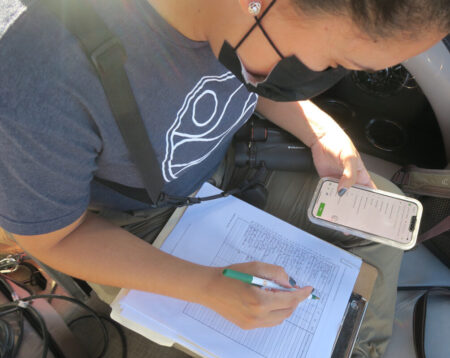
Data from the CWC is all stored on eBird Caribbean. If you take part in the CWC, it is very important that you enter your data using a CWC protocol in eBird. When you submit your sightings on Step 2, under “Observation Type” be sure to pick one of the CWC options. Simply making an eBird list during the regional count dates is not enough—selecting the appropriate protocol is required for it to be ‘counted’ as CWC data.
If you are using the mobile eBird app to collect and submit your data, don’t forget that you need to use the eBird Caribbean portal to see the CWC protocol options (check in your settings).
If you’re new to eBird, check out our helpful video here on how to use eBird and Merlin. And if you need help with eBird submissions (it’s really not complicated!) or with setting up an eBird account, please contact Alex Sansom: waterbird.manager@birdscaribbean.org
Have fun out there!
We hope you have a great time exploring your country’s wetlands and counting birds during the regional CWC count! Please remember to stay safe and carry out your counts responsibly. This means taking care not to disturb the birds or damage their habitats. Enjoy counting birds and see how many of your local wetlands you can visit during this three-week period! Finally, if you enjoy your CWC experience remember that CWC counts are not limited to the regional count. You can do a CWC survey at any time of year as long as you are in a Caribbean wetland and count all the birds you see!
Good luck! We look forward to hearing about your findings. If you need help with bird ID, or have photos and exciting observations to share, please post to our Waterbird Group Listserv (everyone is welcome to join) and/or on our BirdsCaribbean Facebook page. For sharing on social media, use hashtags: #CaribbeanWaterbirdCensus and #WaterbirdsCount AND please tag us: @BirdsCaribbean
Promotional Social Media Graphics – Please feel free to download these graphics and use these to promote your Caribbean Waterbird Census surveys (just open the graphic you want to use right click and choose ‘save image as’) .
If you would prefer to customize our graphic, to add your logo or organization name or want to promote a CWC survey you are organizing you can use our Canva templates to create your own custom CWC 2024 graphics! (these are available in English, Spanish and French in both sizes).
For customizable square graphics use this template link
For customizable 5:4 graphics use this template link
Example images of our customizable graphics, all are available in the template links, in English, Spanish and French

